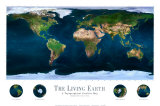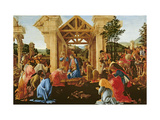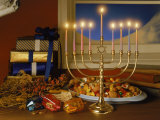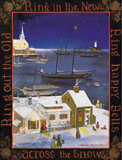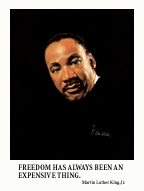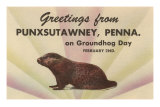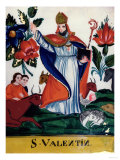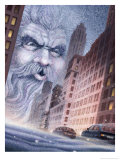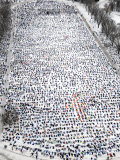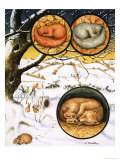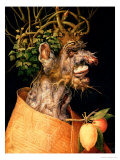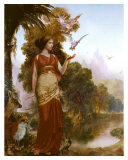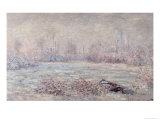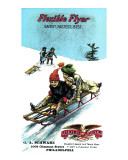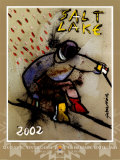|
|
Winter Holidays, Observances, & Notable Dates Posters
for the classroom, home schoolers, and theme decor for offices.
|
social studies > holidays & observances posters > WINTER < weather & climate
|
|
Winter is the coldest season of the year, between the transitional seasons of Autumn and Spring, and the opposite of Summer. The word 'winter', from the old Germanic, has the root meaning of 'the time of water', which is what would be happening with the weather in the form of rain and snow in the higher latitudes. People nearest the poles experience the depth of winter with almost perpetual darkness, and the opposite extreme of almost 24 hours of daylight in the summer.
• animated .gif of seasonal changes.
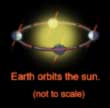 Astronomically Winter is the season from the winter solstice (sol + stitium= stoppage) when the sun is furthest from the celestial equator and the length of time between sunrise and sunset is the least, to when the sun 'crosses' the celestial equator (the projection of the geopgraphical equator on the celestial sphere). In the northern hemisphere the winter solstice is around December 22 and the vernal equinox is around March 22. Astronomically Winter is the season from the winter solstice (sol + stitium= stoppage) when the sun is furthest from the celestial equator and the length of time between sunrise and sunset is the least, to when the sun 'crosses' the celestial equator (the projection of the geopgraphical equator on the celestial sphere). In the northern hemisphere the winter solstice is around December 22 and the vernal equinox is around March 22.
The equinoxes and solstices mark relative positions of the orbiting Earth that has a 23.5° axis tilt to the orbit plane, thus varying the exposure of the northern and southern hemisphere and resulting in seasonal (periodic) changes. Because of this tilt he southern hemisphere experiences summer when the northern hemisphere has winter. Stonehenge is an example of an ancient astronomical observatory, where the people could be assured that the sun was following its usual path.
Weatherwise the Winter season may not match the astronomical dates as the weather is influenced by local geographic landforms, such as large bodies of water, that retain heat.
Another definiton of winter is when plants and animals become dormant. Some plants die and leave seeds for the next generation, others cease growing until longer daylight hours provide enough sunlight for their optimum growth. Some animals hibernate, go into a very deep sleep, in order to conserve energy when its food supply is not available, others migrate to warmer climates, rabbits change the color of their fur and some birds change feather colors to blend into the environment. Some humans suffer from SAD - Seasonal affective disorder also called winter depression, which appears to be related to to daylight.
Greek mythology explained the winter season as the mourning and near death of Demeter, the goddess of agriculture, to her daughter Persephone's abduction to the underworld for six months. Christmas, the Christian holiday celebrating the birth of Jesus, and Chanukah, the Jewish festival of lights, are related to the time when people marked the depth of darkness and the annual rebirth of light.
Also see monthly Observances and Events lists - November list | December list | January list | February list
|
|
|
|
|
|
|
Christmas - Christmas is the annual Christian holiday celebrating the birth of Jesus, on whose teaching the Christian religion is based. The word Christmas is from the Old English and is a contraction of ‘Christ's mass’. When written as Xmas it is because the X resembles the Greek letter ‘chi’, an abbreviation for Christ. ... • more Christmas posters
|
|
|
|
Chanukah - Chanukah, the Festival of Lights, is a celebration of the victory of the Maccabees and the rededication of the Jerusalem Temple commemorating the miracle of the oil that burned for 8 days. ... • more Judaism posters
|
|
|
|
New Year's Eve,
December 31
Did you know? - not all cultures celebrate the beginning of the “new year” on January 1.
|
|
|
|
|
|
| Month of February Holidays posters |
|
February 2nd is the midpoint between Winter Solstice and the Spring Equinox
The date, known as “Candlemas”, has a Scottish rhyme that says “If Candlemas Day is bright and clear, There'll be two winters in the year.”
In the Groundhog tradition, if the “official” groundhog sees his shadow in Punxsutawney, Pennsylvania, we will have six more weeks of winter.
|
|
|
|
Valentine's Day, Feb 14
Valentine's Day is named after two early martyrs of the Christian faith. The tradition of relating the name Valentine to courtly, romantic love wasn't until the Middle Ages when Geoffrey Chaucer used it in his poem 'Parlement of Foules' in 1382, to honor the engagement of Richard II and Anne of Bohemia.
|
|
|
|
|
|
|
Hail, Sleet, and Ice are forms of precipitation:
Hail consists of balls or irregular lumps of ice called hail stones.
Sleet is the intermediate between rain and snow, distinct from hail stones.
Ice is frozen water and variably describes as rain that freezes on contact with objects when it falls.
• more Wild Weather poster series
|
|
|
|
Old Man Winter Blowing Bad Weather into a City
|
|
|
|
Thousands of People Flap Their Arms and Legs, making angels in the snow at the Capitol in Bismarck, ND, on Saturday, Feb 17, 2007.
|
|
|
|
|
|
|
Snowflakes
“In nature, specialness is not for a priveleged few. Every kind of life is unique. It is these millions of differences that make living the adventure that it is.”
|
|
|
|
Winter, from a Series of the Four Seasons, Commissioned by Emperor Maximilian II (1527-76) 1573
Giuseppe Arcimboldo
• optical illusion posters
|
|
|
|
The Greeks explained the change of seasons with the story of Demeter, their mother-goddess of fertility, harvest and the cycle of life and death.
When Demeter's daughter Persephone is abducted by Hades, the god of the underworld, Demeter puts all her energy into the search, thus creating a time of dormancy, a winter.
• goddess posters
|
|
|
|
|
|
|
|
|
|
|
|
|
|
|
|
Stopping By Woods On A Snowy Evening, Robert Frost
|
 |
Whose woods these are I think I know.
His house is in the village though;
He will not see me stopping here
To watch his woods fill up with snow.
My little horse must think it queer
To stop without a farmhouse near
Between the woods and frozen lake
The darkest evening of the year.
He gives his harness bells a shake
To ask if there is some mistake.
The only other sound's the sweep
Of easy wind and downy flake.
The woods are lovely, dark and deep.
But I have promises to keep,
And miles to go before I sleep,
And miles to go before I sleep.
|
|
|
|
previous page | top
|
|
I have searched the web for visual, text, and manipulative curriculum support materials - teaching posters, art prints, maps, charts, calendars, books and educational toys featuring famous people, places and events - to help teachers optimize their valuable time and budget.
Browsing the subject areas at NetPosterWorks.com is a learning experience where educators can plan context rich environments while comparing prices, special discounts, framing options and shipping from educational resources.
Thank you for starting your search for inspirational, motivational, and educational posters and learning materials at NetPosterWorks.com. If you need help please contact us.
|
|
|
|
 Astronomically Winter is the season from the winter solstice (sol + stitium= stoppage) when the sun is furthest from the celestial equator and the length of time between sunrise and sunset is the least, to when the sun 'crosses' the celestial equator (the projection of the geopgraphical equator on the celestial sphere). In the northern hemisphere the winter solstice is around December 22 and the vernal equinox is around March 22.
Astronomically Winter is the season from the winter solstice (sol + stitium= stoppage) when the sun is furthest from the celestial equator and the length of time between sunrise and sunset is the least, to when the sun 'crosses' the celestial equator (the projection of the geopgraphical equator on the celestial sphere). In the northern hemisphere the winter solstice is around December 22 and the vernal equinox is around March 22.













